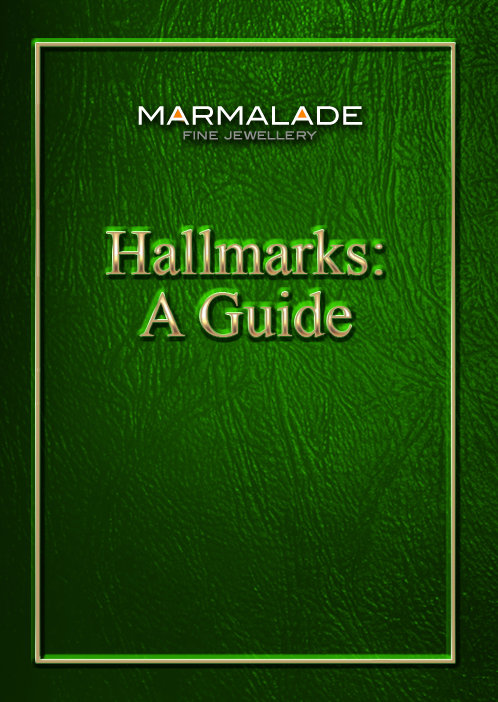

The History of UK Hallmarking
The importance of verifying that something is what it claims to be has always been an issue in the trade of jewellery and precious wares. In part this is because gold, silver and even platinum are not generally used in their pure form to create jewellery or wares. The reason for this is due to both the price of making something in pure precious metal and also the relative softness of using pure precious metal whether it be gold, silver or even platinum. Other metals are added in order to make something more workable, harder or even to add a different colour, for example the "rose" in rose gold is due to the copper it is alloyed with. The fact is that by simply looking at an object one cannot assess whether a less expensive alloying metal has been used, whether an item is simply plated, or what the quantities of precious metal are. There have always been fraudsters or dishonest people who have sought to take advantage of this fact in order to misrepresent an object in order to get a better price. For this reason hallmarking is of vital importance and we are lucky today to have sound peace of mind that what we are buying is in fact what we are being sold; and this is due to the development of the hallmarking process. This booklet will outline a brief history of how this extremely valuable service has come about and help make sense of the jargon of symbols that tell you, as a customer, that the item you are purchasing is 100% that which you think it is.
Why was hallmarking important?
In the Middle Ages the industry was self-regulating and crafts were usually controlled by craft guilds. These guilds had the purpose of fixing prices and wages, looking after the sick or needy members of the craft and ensuring reasonable working conditions. Like other guilds at the time there were long periods of apprenticeships whereby a journeyman would come to learn the necessary skills and guilds would ensure that they were of a sufficient standard before they were allowed to practise the craft for themselves. The belief was that: "bad workmanship or the use of poor materials by the individual could undermine the reputation of the whole craft" . In 1180 the Goldsmiths' Guild was formed in London but by 1238 the number of fraudulent goods in circulation spurred King Henry III to command the Mayor and Alderman of the City of London to choose the six most trustworthy goldsmiths to oversee the craft.
The successors of these initial six men were later the founders of the hallmarking process in the UK. In 1300 King Edward I entrusted these men with the task of assaying every silver item before it was offered for sale. Silver that passed the Sterling Standard of silver was to be stamped with a leopard's head. This was done in the great hall of the Goldsmith's Guild building and thus the term 'hallmarking' was born. King Edward I also introduced a gold standard of 191/5ct: "to work no worse gold than of the Touch of Paris" . Thereby, the old guild received its first Royal Charter from Edward III in 1327 and still remains the responsible body for hallmarking in London. The leopard's head mark used featured a crown until 1820.
The job of Assay Offices today, which is as important as it was under King Henry III, is to test products made of precious metals both manufactured or imported into the UK to ensure that the metals and solders comply with British Standards for Hallmarking i.e. the proportions of precious metal to alloy must meet the minimum permitted legal standards. In London this responsibility even includes testing, on an annual basis, coins that are manufactured by the Royal Mint.
The marks you would see today are the sponsor's mark, the fineness mark, the Assay Office mark and optionally the fineness pictorial mark and the date mark; however this has not always been the case and the development of these marks will be outlined below.
The propagation of Assay Offices:
There are currently four Assay Offices in the UK: London, Sheffield, Birmingham and Edinburgh. It is their responsibility to authenticate items made of precious metals and although their functions are governed by Parliamentary Acts they operate independent of Government control. They operate under statute from the Crown and as such it is a criminal offence to commit hallmarking fraud e.g.to copy or forge a hallmark. However, it was not always up to these four Offices alone. To begin with London was the only such office as mentioned above and had been using the leopard's head as its mark since the decree by King Edward I; however, it was unrealistic to have all items assayed only by London at a time when transport between cities could take days. (Cont...)
In 1700 a new Act brought in Assay Offices in Chester, Exeter, York, Bristol and Norwich and in 1702 Newcastle as well. These dissimilated over the years with the last two offices, Chester closing down in 1962 and Glasgow in 1964. In 1773 and partly due to the efforts of Matthew Boulton, a renowned silversmith, Birmingham and independently Sheffield got their own assay offices to mark silver only; respectively using the Anchor and the Crown as their marks. Birmingham started hallmarking gold in 1824 and Sheffield in 1904. Due to the mark of 18ct gold being made a crown in 1798, when Sheffield started marking gold in 1904, they needed to change their Assay Office mark so as to avoid confusion. They changed their mark from a crown to a York rose for items of gold. In 1959 this further simplified to Sheffield using a rose on all metals not just gold. Edinburgh Assay Office can trace its history to 1457 when the first hallmarking act of Scotland was passed. Edinburgh's Guild was granted its Royal Charter by King James VII in 1687 . Its mark has always been a pictorial representation of their Goldsmiths Hall in the shape of a three-towered castle.
Hallmarks used and what they mean:
As mentioned above the current three compulsory marks that you would see on a UK hallmark are the sponsor's mark, the fineness mark, the Assay Office mark (as detailed above). Today there are also three optional marks: the date mark, pictorial fineness mark and commemorative marks. These marks have developed through the history of hallmarking and were sometimes accompanied by other marks as well. Below the different marks will be discussed in more detail.
Sponsor's mark
Fineness mark
The date mark
Duty marks
Commemorative marks
Imported goods and the Control Mark
Sponsor's mark:
In 1363 master goldsmiths were required to stamp their own mark on items they made. Initially this was usually a pictorial sign and often of the sign hanging above their premises but later initials became more common. In 1696, during the Britannia standard period, a statute by William III declared that pictorial marks were to be replaced by the first two letters of the maker's surname. In 1720, in concomitance with the reintroduction of the sterling standard, all previous marks were destroyed and only the makers' initials were to be used. In 1999 the maker's mark changed name to be the sponsor's mark- the item no longer had to be marked by who made it but instead by the initials of the person or firm responsible for sending the article for assaying be it the manufacturer, retailer, craftsman or hobbyist.
Fineness mark:
The fineness mark today is a number indicating the fineness within a shield that has a different shape according to the metal. Since 1999 all finenesses were indicated by a millesimal number. Prior to 1999 fineness marks were often depicted by a pictorial sign, today this is an optional mark.
Historically, the leopard's head alone had been the sign for silver and gold but in 1544 silver coinage had been debased so much that a new mark was needed to depict Sterling. This new silver standard mark took the form of a lion standing sideways in a shield with its head turned to the left- the lion passant. After the Restoration, following the Civil War during Charles I's reign, demand for silver was high and many silversmiths started clipping silver shillings to create enough raw materials for melting into commissions. This led to the silver shilling becoming increasingly devalued as currency and in 1697 William III set a new standard of silver introduced as the Britannia standard in order to stop this trend. Silverware now had to be of a higher quality than the silver coinage. The Britannia mark showed a seated figure of Britannia with her shield and spear. Moreover, the leopard's head mark was replaced by a lion's head erased until 1999, where the London Assay Office's mark reverted to the leopards head. It was a mark to distinguish Britannia standard silver 958.4 ppt fineness from sterling standard silver 925 ppt fineness. It was not until 1720 that the sterling standard was restored as the minimum standard. In Scotland the lion rampant was, at times, used instead of the lion passant to denote the sterling standard: a lion depicted in profile standing erect with forepaws raised. This was the case in the Assay Offices of Glasgow between 1819 until it closed down in 1964 and in Edinburgh between 1975 and 1999 when the mark for sterling silver was unified throughout the UK. Prior to that the sterling mark for silver assayed in Edinburgh was the thistle. (Cont...)
Gold has also changed throughout the years, specifically with regards to the minimum legal standards that were accepted; for example between 1477 and 1575 the minimum legal standard for gold was 18ct. In 1575 it was decided that the minimum legal standard should be higher and until 1798 gold had to be 22ct fineness; however this statute was not clearly drafted and as a result some items were not marked at all. In 1798 there was a re-clarification of hallmarking statutes and part of this was to lower the minimum standard of gold back to 18ct. The increase in demand and popularity of watchmakers and watches made of gold meant that in 1854 the gold standard was further reduced to make 9ct gold the minimum standard. 12ct and 15ct gold were also recognised as legal in part due to foreign competition for gold pieces; however, these standards were not marked with the crown as had been the traditional pictorial mark for gold, instead they only featured numerical figures. It was not until 1932 that 14ct replaced the 12ct and 15ct standards of gold but with 9ct still being the minimum. The pictorial mark for gold was marked the same way as for silver until 1798. The leopard's head, followed by the lion passant in 1544, until it got its own mark in 1798: which was the crown marked usually with the fineness number following.
The act of 1973 (that came into force in 1975) established that for platinum metalwork the pictorial mark of an orb with a cross had to be struck for platinum of the standard of 950 ppt. As with all the pictorial marks, this became an optional way of displaying fineness after the 1999 Hallmark Act.
The date mark:
The practise of stamping a date letter started in 1478 to show in which year an item was submitted for assay. As with everything in the history of hallmarking the date mark has not always been there and has not always had the same rules applied to it. For example, in London, the changing of the date letter mark was always on St. Dunstan's Day May 19th, Birmingham and Chester would change the date letter on July 1st, Sheffield in July on whatever day followed the office's annual general meeting, Edinburgh on the day following the third Thursday in October and Glasgow the first Monday in July. This chaotic situation changed only so recently as 1975 wherein the date letter for all Assay Offices was set to change on the 1st of January each year. Moreover, from 1975, all offices used the same font and same number of alphabet letters. Previously different offices used different fonts, styles and omitted or repeated letters at random. From its inception in 1478 until 1999 the date letter indicating the year of hallmarking was compulsory. It is now an optional mark.
Duty marks:
In 1720, when Sterling standard was reinstated after the compulsory use of the Britannia standard (as mentioned above), a 6 pence duty per troy ounce of silver was imposed on silverware production and trade in UK. This amount was relatively quite high, roughly equalling the same price requested by a silversmith for its manufacture . As such, the temptation for a silversmith to be dishonest and "dodge the duty" was consequently very high, despite the punishment of a death sentence imposed for hallmarks forgery or transposing: "Some dishonest silversmiths used spoons or little salt cellars (paying a small duty for the standard verification of the Assay Office) cutting their hallmarks and soldering on pieces of higher weight" . It was this duty dodging which led to the use of a duty mark being statutory and the duty on silver and gold being repealed. Instead in 1758 a tax was introduced for any activity producing and selling silver and gold. With the exemption of the 1738 list that was produced of all items with exemptions from hallmarking (and for gold these exemptions remained in force until 1975); however for the purpose of this booklet the list of exemptions from all Acts shall not be detailed.
In December 1784 a new duty was imposed to support the expensive military front for the secession war in North America. The new mark, the profile of the reigning Sovereign was introduced to demonstrate that payment had been made. On silver marked between 1784 and 1890 we can find the profile of George III (1784-1820), George IV (1821-1830), William IV(1831-1836) and Victoria (1837-1890). (Cont...)
All these marks show the Sovereign's profile looking right with the exception of the mark of George III in use between 1st December 1784 and 30th of April 1785 (the so called 'incuse', being impressed in depth on the silver), and those of Queen Victoria, which are looking left. From 1890 there was no longer any Duty Marks and consequently no duty either on the production or trade of silver and gold. The only restriction since 1890 was between 1942 and 1952, whereby wedding rings were limited to 9ct gold and weighed only 2dwts due to shortages of resources during World War II. The Utility mark was used to depict items had adhered to this new regulation.
Commemorative marks:
Since duty was abolished, the mark of the Sovereign's head in profile appeared again four times: 1933-35 silverwares stamped with the Jubilee mark showed the double profile of King George V and Queen Mary to celebrate the 25th anniversary of their accession to the throne; 1952-54 gold and silverwares were stamped with the Coronation mark showing the profile of Queen Elizabeth II; in 1977 Queen Elizabeth II's profile was used on wares weighing 15g or over to mark her silver Jubilee; and finally 2011-12 Queen Elizabeth II's profile within a diamond shape shield was used to celebrate her Diamond Jubilee.
There has also been a commemorative mark to celebrate the Millennium: the Millennium mark took the form of the numbers 2000 within a square cross.
Imported goods and the Control Mark:
Finally, this booklet will briefly discuss the final mark you are likely to see on a piece today: the convention mark. This can be used on pieces made in the UK as well as pieces that have been imported.
There has always been a trade in silver and gold items from abroad, as mentioned above sometimes this directly influenced the standard of fineness used in the UK, for example the introduction of 15ct gold. Various measures have, throughout the years, been put in place to ensure some control of quality. In 1867 a statute decreed that imported wares had to be assayed and have an 'F' added to the hallmark. In 1904, a completely different set of hallmarks were introduced for foreign goods and in 1906 even some of the Town Marks were altered for foreign goods in order to make the difference as noticeable as possible.
In 1973 a common agreement on imported and exported items was subscribed to by Austria, Finland, Norway, Sweden, Switzerland and Portugal by signing the Vienna Convention on the Control of the Fineness and the Hallmarking of Precious Metal Objects. This stated that items that are assayed and found to be in conformity by the qualifying office of a signatory country, would receive a mark, known as the Common Control Mark (CCM), attesting to the material's fineness and its adherence to hallmarking laws in those countries. The CCM mark features a set of balance scales superimposed on two intersecting circles for gold; on a diamond shape for platinum and for silver a mark in the shape of the Latin letter M. It forms a part of the Convention mark to show that an item can be exported to any other Convention country and sold there without further testing or marking. (Cont...)
In 1973 the UK became a member of the Vienna Convention, as well as introducing a hallmark for platinum which was a recognised metal under the Convention. The 1999 Act further brought the UK hallmarking system closer in line with the European Union. The Hallmarking Act was further amended in July 2009 to include palladium from January 2010. The Convention mark has four parts: the sponsor's mark, the common control mark, the fineness repeated, and finally the town or national assay office mark.
This brief history has sought to introduce you to the fascinating subject of hallmarking. It has been a system that has developed throughout the years in order to safeguard consumers and regulate the industry: to give you peace of mind about items purchased. It is continuously developing to cater for the way in which we use, make and enjoy precious metal goods: be that the use of new metals, the standard of fineness, mixed metals or the import of goods.
i Pp138, Kenneth Blakemore, revised by Eddie Stanley, The Retail Jeweller's Guide Sixth Edition, N.A.G Press, 2000
ii Pp138, Kenneth Blakemore, revised by Eddie Stanley, The Retail Jeweller's Guide Sixth Edition, N.A.G Press, 2000
iii http://en.wikipedia.org/wiki/Edinburgh_Assay_Office
iv http://www.argentinglesi.com/marchi-garanziaing.php
Bibliography
- Kenneth Blakemore, revised by Eddie Stanley, The Retail Jeweller's Guide Sixth Edition, N.A.G Press, 2000
- http://en.wikipedia.org/wiki/Edinburgh_Assay_Office
- http://www.argentinglesi.com/marchi-garanziaing.php
- Jet 2 Course Notes, Hallmarking Chapter, The National Association of Goldsmiths
- http://en.wikipedia.org/wiki/Hallmark







